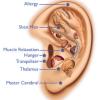CYBERMED LIFE - ORGANIC & NATURAL LIVING
CYBERMED LIFE - ORGANIC & NATURAL LIVING
 Acupressure Auricular is a form of acupuncture, based on traditional Chinese medicine (TCM) that uses specific acupoints (hereafter, points) on the inner and outer ear lobe to treat disease and illness . APA is similar to acupuncture, but points on the ear are stimulated without using needles. Instead, an acupuncturelike stimulation (e.g., small seeds are taped to ear points and pressed with the index finger and thumb) is used to treat symptoms .
Acupressure Auricular is a form of acupuncture, based on traditional Chinese medicine (TCM) that uses specific acupoints (hereafter, points) on the inner and outer ear lobe to treat disease and illness . APA is similar to acupuncture, but points on the ear are stimulated without using needles. Instead, an acupuncturelike stimulation (e.g., small seeds are taped to ear points and pressed with the index finger and thumb) is used to treat symptoms .
Auricular therapy originated in China more than 2,000 years ago and was redeveloped by the French neurosurgeon Dr. Paul Nogier in 1957 . By 1990, the WHO had established a standardized, internationally accepted nomenclature of ear points and their location . The underlying theory of auricular therapy posits that nerves in the outer ear correspond to specific areas of the brain, and these areas have a reflex connection with specific parts of the body . The correlation of ear points and brain activity has been validated by functional MRI . The treatment of ear points can stimulate the brain to correct its pathological reflex centers , change levels of serum pro- and anti-inflammatory biomarkers , and induce reflex reactions to relieve body pathology . Some auricular points can treat multiple symptoms and APA may significantly lower the risk of polypharmacy and resultant systemic toxicities .